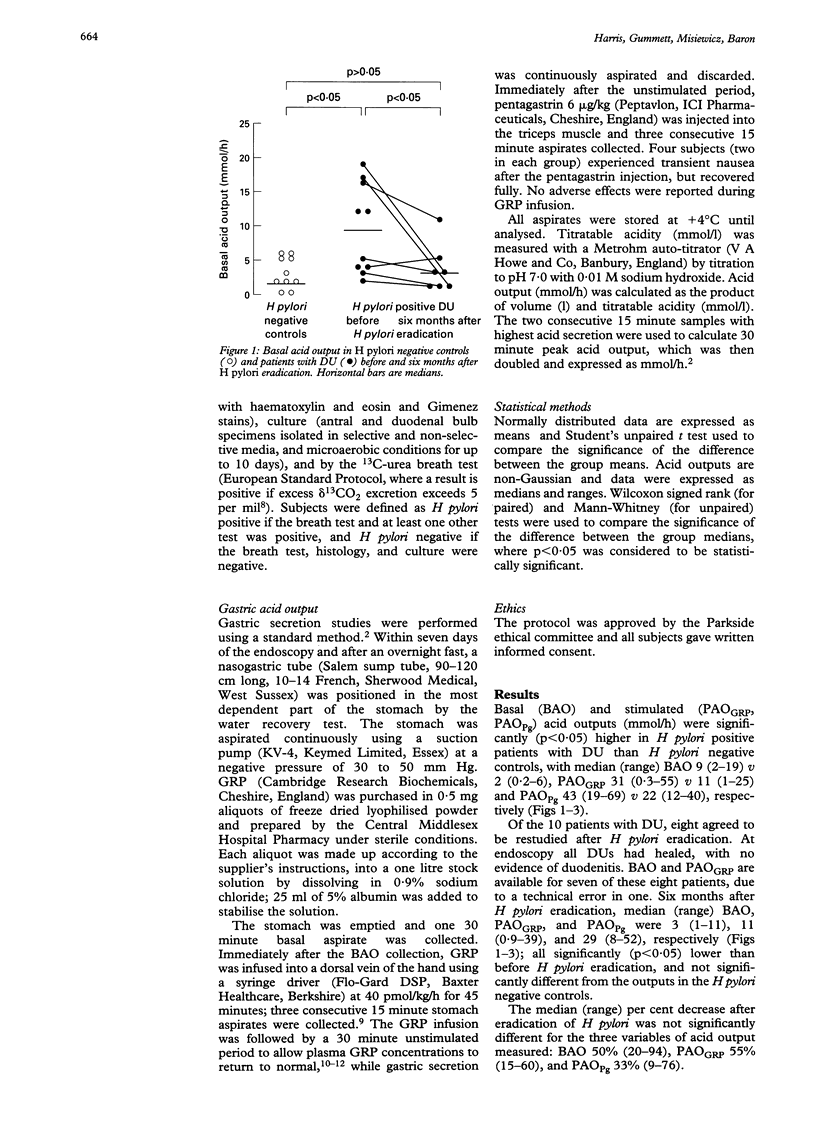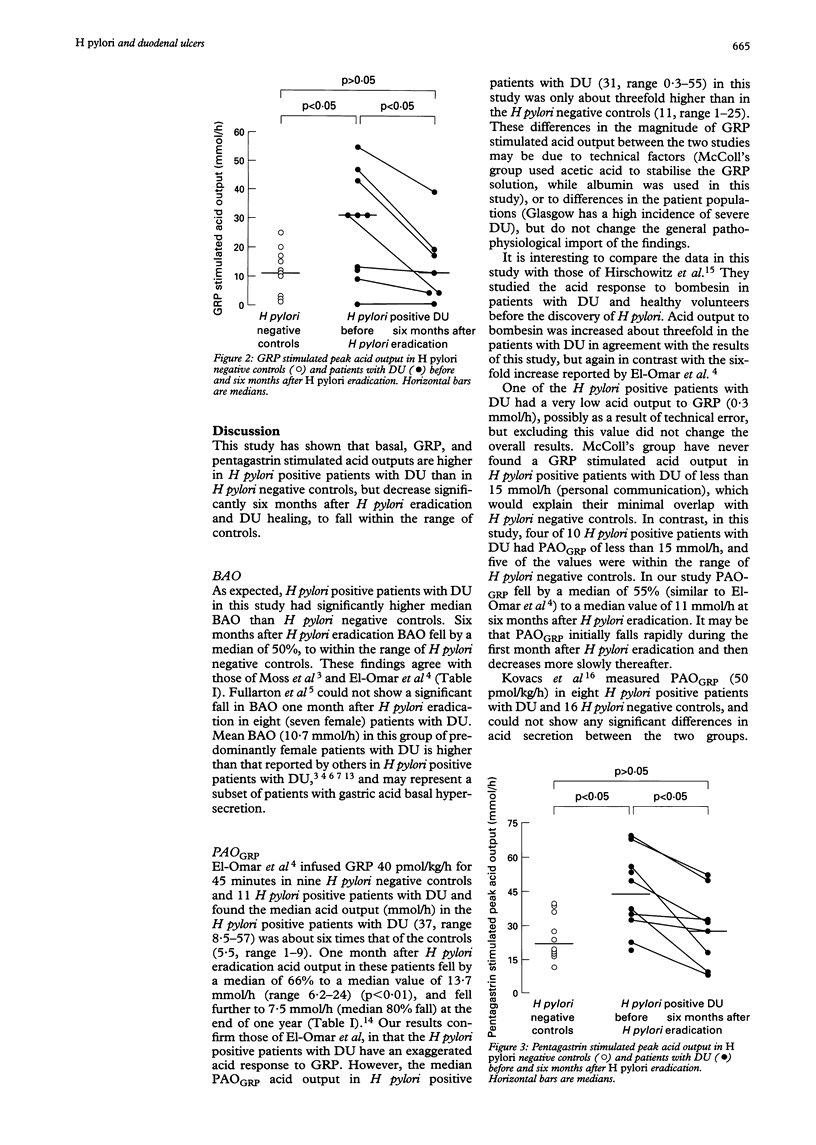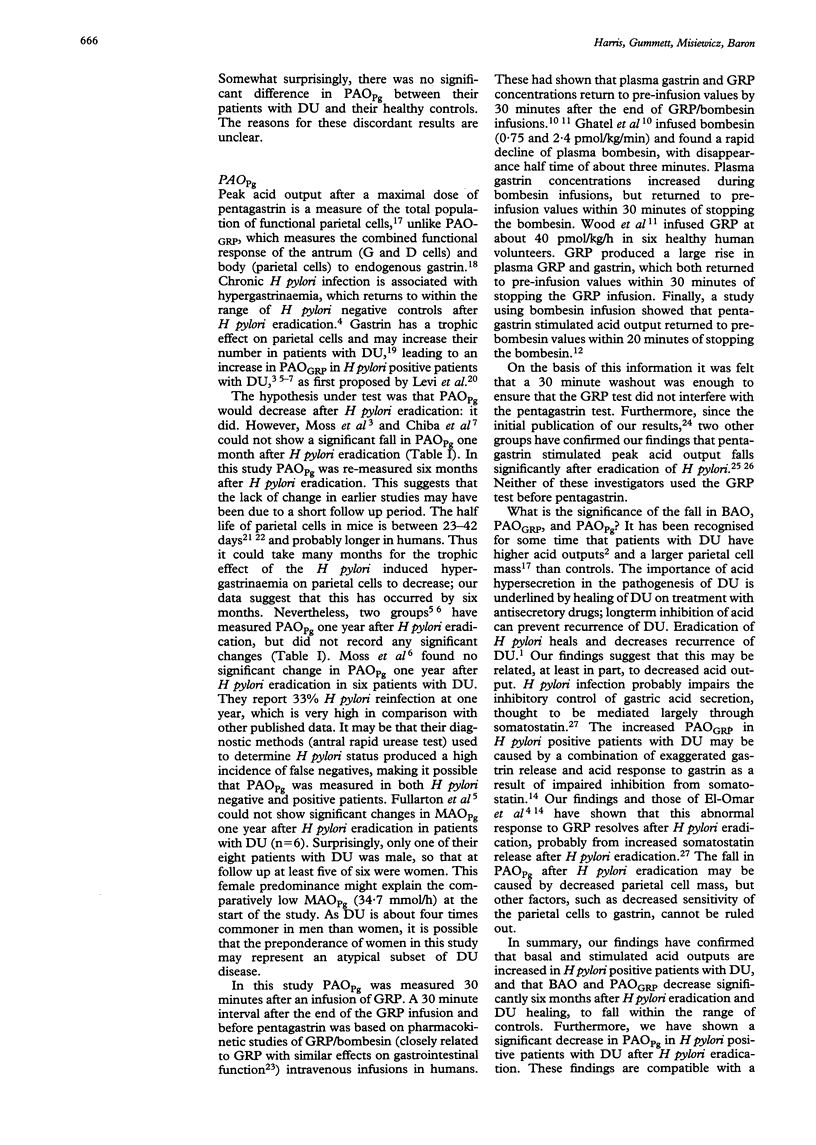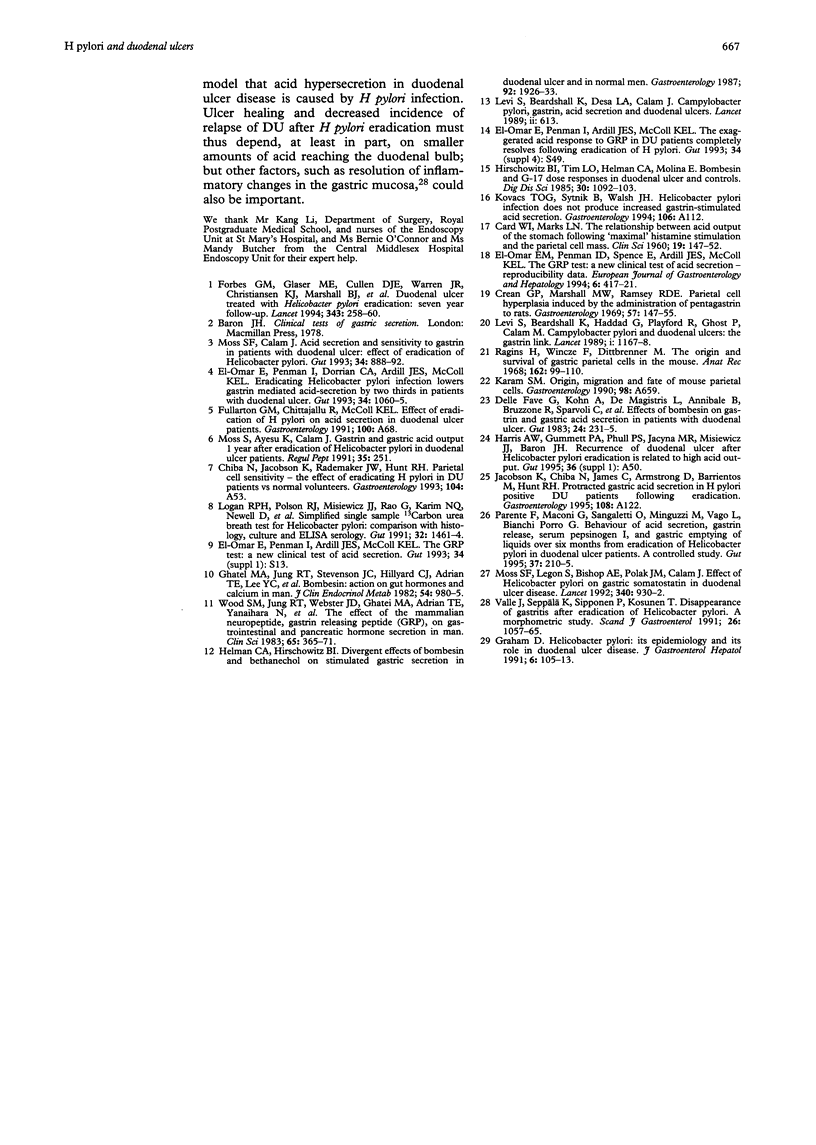Abstract
BACKGROUND--Patients with duodenal ulcer (DU) have high basal (BAO) and peak (PAO) acid outputs. The effect of Helicobacter pylori eradication on these variables is unclear. AIM--To discover if gastric acid hypersecretion in patients with DU is caused by H pylori. PATIENTS AND METHODS--BAO, gastrin releasing peptide (GRP), and pentagastrin stimulated PAO in 10 H pylori negative controls, and in 10 H pylori positive patients with DU was measured before and six months after H pylori eradication. H pylori status was determined by histology, culture, and by the 13C-urea breath test. After collecting a 30 minute basal aspirate, GRP 40 pmol/kg/h was infused for 45 minutes, and after a 30 minute washout, pentagastrin 6 micrograms/kg was injected intramuscularly. RESULTS--Basal and stimulated acid output (PAOGRP and PAOPg) were significantly higher in H pylori positive DU than in H pylori negative controls. Six months after H pylori eradication, basal and stimulated acid outputs were all significantly lower than before H pylori eradication. CONCLUSIONS--This study has shown that BAO, PAOGRP, and PAOPg are higher in H pylori positive DU than in H pylori negative controls. All decreased significantly six months after H pylori eradication, to fall within the range of controls. These results are compatible with a hypothesis that acid hypersecretion in duodenal ulcer disease is caused by H pylori infection.
Full text
PDF




Selected References
These references are in PubMed. This may not be the complete list of references from this article.
- CARD W. I., MARKS I. N. The relationship between the acid output of the stomach following "maximal" histamine stimulation and the parietal cell mass. Clin Sci. 1960 Feb;19:147–163. [PubMed] [Google Scholar]
- Crean G. P., Marshall M. W., Rumsey R. D. Parietal cell hyperplasia induced by the administration of pentagastrin (ICI 50,123) to rats. Gastroenterology. 1969 Aug;57(2):147–155. [PubMed] [Google Scholar]
- Davies M. H., Elias E., Acharya S., Cotton W., Faulder G. C., Fryer A. A., Strange R. C. GSTM1 null polymorphism at the glutathione S-transferase M1 locus: phenotype and genotype studies in patients with primary biliary cirrhosis. Gut. 1993 Apr;34(4):549–553. doi: 10.1136/gut.34.4.549. [DOI] [PMC free article] [PubMed] [Google Scholar]
- Delle Fave G., Kohn A., De Magistris L., Annibale B., Bruzzone R., Sparvoli C., Severi C., Torsoli A. Effects of bombesin on gastrin and gastric acid secretion in patients with duodenal ulcer. Gut. 1983 Mar;24(3):231–235. doi: 10.1136/gut.24.3.231. [DOI] [PMC free article] [PubMed] [Google Scholar]
- Digestive Disease Week and the 95th Annual Meeting of the American Gastroenterological Association. New Orleans, Louisiana, May 15-18, 1994. Abstracts. Gastroenterology. 1994 Apr;106(4 Suppl):A1–1198. [PubMed] [Google Scholar]
- Forbes G. M., Glaser M. E., Cullen D. J., Warren J. R., Christiansen K. J., Marshall B. J., Collins B. J. Duodenal ulcer treated with Helicobacter pylori eradication: seven-year follow-up. Lancet. 1994 Jan 29;343(8892):258–260. doi: 10.1016/s0140-6736(94)91111-8. [DOI] [PubMed] [Google Scholar]
- Ghatei M. A., Jung R. T., Stevenson J. C., Hillyard C. J., Adrian T. E., Lee Y. C., Christofides N. D., Sarson D. L., Mashiter K., MacIntyre I. Bombesin: action on gut hormones and calcium in man. J Clin Endocrinol Metab. 1982 May;54(5):980–985. doi: 10.1210/jcem-54-5-980. [DOI] [PubMed] [Google Scholar]
- Graham D. Y. Helicobacter pylori: its epidemiology and its role in duodenal ulcer disease. J Gastroenterol Hepatol. 1991 Mar-Apr;6(2):105–113. doi: 10.1111/j.1440-1746.1991.tb01448.x. [DOI] [PubMed] [Google Scholar]
- Helman C. A., Hirschowitz B. I. Divergent effects of bombesin and bethanechol on stimulated gastric secretion in duodenal ulcer and in normal men. Gastroenterology. 1987 Jun;92(6):1926–1933. doi: 10.1016/0016-5085(87)90626-3. [DOI] [PubMed] [Google Scholar]
- Hirschowitz B. I., Tim L. O., Helman C. A., Molina E. Bombesin and G-17 dose responses in duodenal ulcer and controls. Dig Dis Sci. 1985 Nov;30(11):1092–1103. doi: 10.1007/BF01315608. [DOI] [PubMed] [Google Scholar]
- Levi S., Beardshall K., Desa L. A., Calam J. Campylobacter pylori, gastrin, acid secretion, and duodenal ulcers. Lancet. 1989 Sep 9;2(8663):613–613. doi: 10.1016/s0140-6736(89)90728-9. [DOI] [PubMed] [Google Scholar]
- Levi S., Beardshall K., Haddad G., Playford R., Ghosh P., Calam J. Campylobacter pylori and duodenal ulcers: the gastrin link. Lancet. 1989 May 27;1(8648):1167–1168. doi: 10.1016/s0140-6736(89)92752-9. [DOI] [PubMed] [Google Scholar]
- Logan R. P., Polson R. J., Misiewicz J. J., Rao G., Karim N. Q., Newell D., Johnson P., Wadsworth J., Walker M. M., Baron J. H. Simplified single sample 13Carbon urea breath test for Helicobacter pylori: comparison with histology, culture, and ELISA serology. Gut. 1991 Dec;32(12):1461–1464. doi: 10.1136/gut.32.12.1461. [DOI] [PMC free article] [PubMed] [Google Scholar]
- Moss S. F., Calam J. Acid secretion and sensitivity to gastrin in patients with duodenal ulcer: effect of eradication of Helicobacter pylori. Gut. 1993 Jul;34(7):888–892. doi: 10.1136/gut.34.7.888. [DOI] [PMC free article] [PubMed] [Google Scholar]
- Moss S. F., Legon S., Bishop A. E., Polak J. M., Calam J. Effect of Helicobacter pylori on gastric somatostatin in duodenal ulcer disease. Lancet. 1992 Oct 17;340(8825):930–932. doi: 10.1016/0140-6736(92)92816-x. [DOI] [PubMed] [Google Scholar]
- Parente F., Maconi G., Sangaletti O., Minguzzi M., Vago L., Bianchi Porro G. Behaviour of acid secretion, gastrin release, serum pepsinogen I, and gastric emptying of liquids over six months from eradication of helicobacter pylori in duodenal ulcer patients. A controlled study. Gut. 1995 Aug;37(2):210–215. doi: 10.1136/gut.37.2.210. [DOI] [PMC free article] [PubMed] [Google Scholar]
- Ragins H., Wincze F., Liu S. M., Dittbrenner M. Theorigin and survival of gastric parietal cells in the mouse. Anat Rec. 1968 Sep;162(1):99–110. doi: 10.1002/ar.1091620109. [DOI] [PubMed] [Google Scholar]
- Valle J., Seppälä K., Sipponen P., Kosunen T. Disappearance of gastritis after eradication of Helicobacter pylori. A morphometric study. Scand J Gastroenterol. 1991 Oct;26(10):1057–1065. doi: 10.3109/00365529109003956. [DOI] [PubMed] [Google Scholar]
- Wood S. M., Jung R. T., Webster J. D., Ghatei M. A., Adrian T. E., Yanaihara N., Yanaihara C., Bloom S. R. The effect of the mammalian neuropeptide, gastrin-releasing peptide (GRP), on gastrointestinal and pancreatic hormone secretion in man. Clin Sci (Lond) 1983 Oct;65(4):365–371. doi: 10.1042/cs0650365. [DOI] [PubMed] [Google Scholar]
- Yano M., Yatsuhashi H., Inoue O., Inokuchi K., Koga M. Epidemiology and long term prognosis of hepatitis C virus infection in Japan. Gut. 1993;34(2 Suppl):S13–S16. doi: 10.1136/gut.34.2_suppl.s13. [DOI] [PMC free article] [PubMed] [Google Scholar]
- el-Omar E., Penman I., Dorrian C. A., Ardill J. E., McColl K. E. Eradicating Helicobacter pylori infection lowers gastrin mediated acid secretion by two thirds in patients with duodenal ulcer. Gut. 1993 Aug;34(8):1060–1065. doi: 10.1136/gut.34.8.1060. [DOI] [PMC free article] [PubMed] [Google Scholar]


